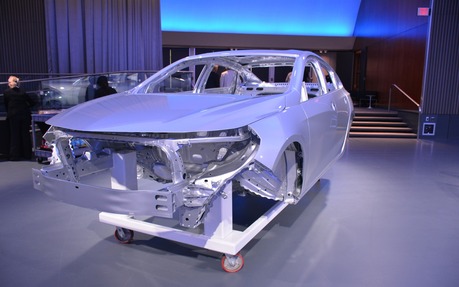GM Takes Meticulous Approach to Weight Savings
WARREN, Michigan – A couple years back, Ford made a big splash with its F-150 pickup made of mostly aluminum. Ford's rhetoric focused on a savings of 700 lbs., but in the background lurked many of its competitors, as they kept one eye on how things were going at the Blue Oval and another on its own weight savings configurations.
This battle for materials has been waged for the sake of fuel economy and meeting the future global demands of certain markets. Some of the strictest rules come from these companies’ biggest markets, China and the United States, and in order to adhere to these rules of fuel efficiency and emissions, automakers have to shift gears to more pure electrics or hybrids. But before they can do all that, every vehicle has to be made lighter.
General Motors’ strategy takes on a different approach than Ford with a mix of aluminum, high-strength steel, magnesium and carbon fibre to shed those pounds. And to get a closer look and understanding of what they do, they invited a select host of journalists to its technical centre in Warren, Michigan to talk with some of its experts.
“There is no one single material solution,” said Charles Klein, Executive Director Global CO2 Strategy and Energy Center Engineering. “We use the best material for each component.”
This philosophy of 'Every Engineer Part Gram Matters' is adopted to its core. GM is all about the fine details and it's constantly looking at alternatives with a dollars-per-kilogram-saved mindset.
The Detroit brand can already boast (and they did) a total combined weight savings of 2400 lbs. from its seven new vehicles versus its previous model-year version, which broken down is an average of 300 lbs. per new vehicle. All of these weight savings contribute to the reduction of carbon dioxide emissions, as well as improved driving dynamics, enhanced safety and a quieter ride.
Impressive as that is, these weight reductions have been achieved before any of these new tricks that we discovered in Warren have been implemented. Let's take a closer look at some of GM's workings coming up the pipeline.
Aluminum-to-Steel Spot Welding
The bringing together of aluminum-to-aluminum welding took many years to develop, and now GM is only months away from its implementation of a patent-pending, aluminum-to-steel spot welding process. A system that typically brings about premature weld failure in the forms of a glossy, metallic substance forming or aluminum oxides. But according to GM, they have worked on this in-house process for two years and are ready to use it on future vehicles, starting with a seatback construction in its Cadillac CT6, followed by a steel hood support fixture to be applied to the inner side of its aluminum hood.
“It's all about developing tools and understanding physics,” said Blair Carlson, Lightweight Material Processing Lab Group Manager, Research & Development.
You really have to understand physics to grasp this concept, and they didn't fully divulge what they do. However, the process involves electrode geometry, a unique welding tip dressing and a weld schedule, all through its existing infrastructure and without any special tools. From this use of physics, GM is able to lessen the amount of rivets used that help cut not only costs, but that more important poundage. Currently in the CT6, 196 parts have been eliminated and that number will only decrease through this technique.
The proof of GM's accomplishments can be seen by the interest from other automakers in licensing its technology. There's been initial talks with others, but nothing has been agreed upon as of yet.
Magnesium to the rescue
Another focus of the event centred around magnesium, a more costly lightweight metal that's already being used on the rear liftgate of the 2017 Chrysler Pacifica minivan.
Compared to high-strength steel, magnesium offers an extra mass reduction of 30%, only trailing carbon fibre, which is also being looked into for more high-end GM wheels. But once again, adding magnesium comes down to a cost benefit being balanced against having the right materials for the right location in each vehicle.
One of the items on display was the inner panel of a car door, the other a decklid, both completely made out of injection-moulded magnesium. We will focus on the door, as beside it was the regular steel door that has seven different joining parts to it, while the magnesium version only has the one. Not only does the magnesium version save on production time, taking only 90 seconds to make, it cuts down half the weight of the door, from 8.9 kg to 4.6.
When asked about how long the steel door takes to make, Dr. Anil Sachdev, Light Metals Systems Lab Group Manager, Research & Development couldn't even come up with a time and just pointed to the amount of bolts and welds that needed to be worked on in order to make this single steel door.
Dr. Sachdev goes on to explain that GM is always looking at options and magnesium could be used in seats, steering wheels or whatever else they can figure out.
Conclusion
One thing’s for sure, if a material can reduce weight, improve the vehicle in any fashion and do it in a cost-effective manner, we will see it a future GM product. With an overhaul expected of many of its vehicles by 2020, GM will certainly use several of these upcoming mixed material techniques to lower its weight totals along with its fuel economy numbers.
